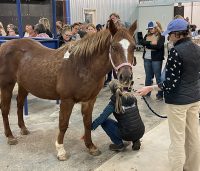Location key issue in assessing wounds

This small laceration was a concern because of its close proximity to the pastern joint and tendon sheath. Photos: Dr. Suzanne Mund.
Horses can suffer from all types of wounds, and while some wounds look much worse than others, the primary assessment of their severity is the same as that of gauging housing prices: location, location, location.
This claim is backed by Dr. Suzanne Mund, a master’s degree student in the Western College of Veterinary Medicine’s Department of Large Animal Clinical Sciences. Her research focus is on wound healing through the use of stem cells.
“It doesn’t matter necessarily how big the wound is, what matters more is where it is,” stresses Mund. “Size doesn’t matter when it comes to wounds, at least not as much. A larger wound in a safer place isn’t as bad as a tiny, little puncture wound over top of the joint.”
Because of the increased risk of bleeding and infection, more severe wounds often occur in locations with more blood vessels: between the hind legs, up in the arm pits, along the jugular vein and underneath the skin. Wounds on the backs of legs are also serious because of the potential damage to vital ligaments and tendons.
Wounds in high-motion areas – mainly joints – increase the risk for major complications. One serious condition is when gas or air becomes trapped underneath the horse’s skin (subcutaneous emphysema).
“As the horse walks, the wound [continually] gapes open and closed and air is pushed up underneath the skin can spread throughout the body,” explains Mund. If the air dissects along the front of the horse’s chest and in to the potential space between the lungs and the heart, it can cause a collapsed lung that requires emergency care.

This limb wound is about five days old. By the time it was examined by a veterinarian, the wound was inflamed and had exudate (a mass of cells and fluid).
Mund emphasizes that any wounds found in highly vascular regions or around joints should be immediately checked by a veterinarian. Lacerations — tears or cuts on the skin — are comparatively less serious and can be usually treated by simply flushing, draining and suturing them. Mund recommends calling the veterinarian early, particularly to avoid the growth of too much granulation tissue (or proud flesh) on the limbs and/or around joints.
Puncture wounds are potentially more dangerous than open lacerations because they can carry debris and bacteria deep down into the bottom of the wound, says Mund. “The outside can heal before the inside has healed, which can set up an environment for abscess formation or increase the risk for developing gas gangrene or tetanus.”
Given their small size, puncture wounds can be easily missed and swelling can often obscure the original wound. Complications don’t always arise from puncture wounds, but they usually require intensive veterinary management regardless of their severity.
If a horse suddenly becomes lame, Mund says to check for leg wounds or a possible foot abscess. She recommends that owners contact their local veterinarian to pinpoint the cause.
“Nine times out of 10, [lameness is caused by] a foot abscess, which is easy to manage,” says Mund. “It’s the other one out of 10 times that it’s something more serious such as septic joints, broken bones, or an injury involving torn ligaments.”
Wounds usually cause bleeding. Improper treatment of a bleeding wound may do more harm than good, especially if a horse owner tries to remove an object that’s causing the bleeding.
“If you see a nail or another type of foreign body, it’s very important not to remove that until you call the veterinarian,” says Mund. “It’s better to have the vet examine the wound (often through X-ray) and determine the appropriate treatment.”
Horse owners should immediately call their veterinarian if a wound exposes internal structures.

The same wound 21 days after the injury. It has contracted as the skin edges have pulled together and more skin is growing toward the centre of the wound.
“Any exposed [bones], ligaments or tendons need to get healed as soon as possible, as these are vital structures that can impact the future use of your horse,” says Mund.
While owners can’t completely protect their horses from everything, properly maintaining fences can help to avoid accidents.
“It’s important to go walk the perimeter of your fence at least twice a year and look for loose wire and loose nails sticking out,” recommends Mund. “It doesn’t really matter what type of fencing material you decide to use; what’s more important is how you maintain it. Loose, smooth wire can be just as bad as barbed wire [if improperly maintained].”
And while veterinarians are the trained experts in wound management, owners can proactively improve their horse’s outcome by preparing the horse before the vet arrives.
For example, lead the horse (if it can still walk) to a quiet area, perhaps with a calming, equine companion, and follow the veterinarian’s advice on stemming any bleeds.
However, Mund emphasizes not to clean any wound unless explicitly instructed.
Overall, if any horse owner spots a wound and is unsure of what to do, Mund recommends contacting a vet – even if it’s just for a consultation on the phone.
“Advice is free,” says Mund. “Addressing a small problem now will prevent larger problems in the future.”
Brenden Van Wyk completed his Master of Science (MSc) degree at the Vaccine and Infectious Disease Organization (VIDO) in 2016. Reprinted with permission from Canadian Horse Journal (horsejournals.com) and the WCVM Townsend Equine Health Research Fund (tehrf.ca).

